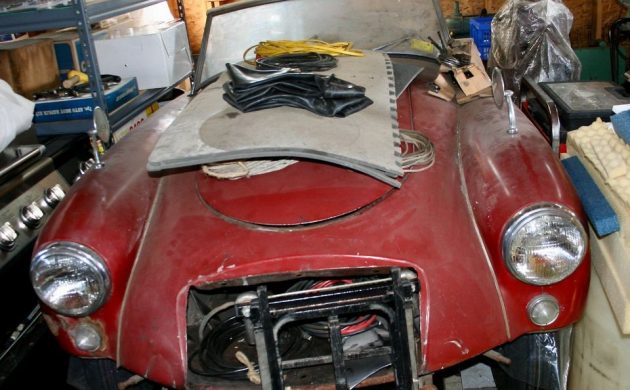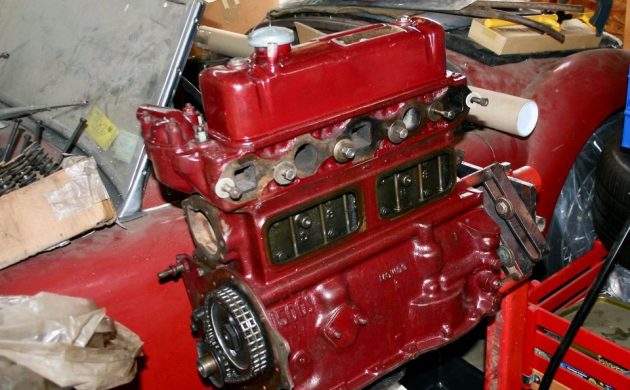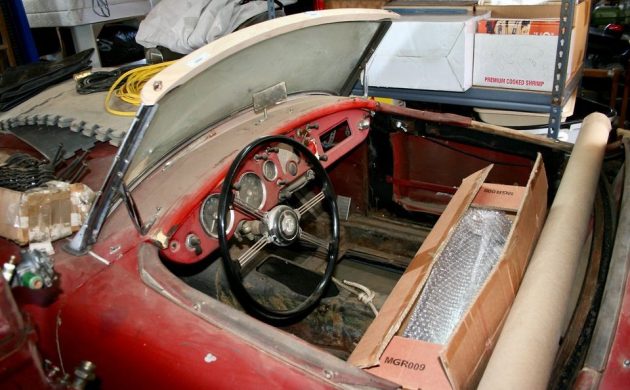One of the most significant challenges an owner can face when purchasing a project car is determining what parts they will require to return their new toy to its pristine best. The person who buys this 1959 MGA will face fewer hurdles than most because the seller includes an enormous collection of parts to get the ball rolling. If a classic British sports car has been on your radar, this MGA Roadster could be worth a closer look. Located in New Hartford, New York, the seller has listed the MG for sale here on Facebook. You could take this project home by handing them $16,000. I have to say a big thank you to Barn Finder Scott E for spotting this promising project for us.
The photos supplied by the owner aren’t great, but they compensate for this shortcoming by providing plenty of relevant information in their listing. The MG wears Orient Red paint, which was available throughout the production life of the MGA 1500. It’s no surprise that the paint looks tired, which means the buyer will face the prospect of a total restoration for the Roadster to present at its best. The owner mentions no rust issues, and there are no nasty problems visible in the supplied photos. I would probably consider a frame-off approach if I were tackling this project. With the car in its present state, totally dismantling it would not be challenging, and the finished product would be worth the effort. If that idea seems daunting, maybe the list of shiny new parts might be enough to motivate the buyer to go that extra yard on this project. The seller includes a new soft-top, tonneau, aluminum side curtains, a complete body rubber kit, new bumpers, a new grille, lights and lenses, and a shiny new set of beautiful 60-spoke wire wheels. With so many fresh parts, completing the remaining panel and paint tasks to a high standard should be worth the effort.
When the MGA rolled out of the factory in Abingdon, England, it featured a 1,489cc four-cylinder engine that sent its 72hp to the rear wheels via a four-speed manual transmission. Tipping the scales at a featherweight 2,050lbs, the MG could cover the ¼ mile in 19.8 seconds. That figure will hardly cause a muscle car owner sleepless nights, but outright performance is not the MGA’s forte. These classics are more at home on twisting roads and country lanes where a driver can exploit their low weight and agile nature. I underestimated these classics until the day I slipped behind the wheel of one for the first time. The driver’s proximity to Planet Earth is deceptive, making an MGA feel faster than it genuinely is. There remains plenty of good news for potential buyers when we begin to tackle its mechanical components. The 1,489cc engine presents superbly after a complete rebuild and is begging to be slotted back under the hood. However, if the buyer craves more power and is unconcerned about originality, there is a spare 1,800cc engine that they could drop into the engine bay to unlock improved performance.
If a 1958 MGA wore Orient Red paint, the company offered interior trim limited to Red or Black. The dash suggests that the original owner selected the first color, and first impressions indicate that the buyer may face a significant outlay for fresh interior trim. However, that isn’t the case. The seller includes a new interior trim kit in Grey leather and a new carpet set. While this combination may not be original, I would probably still install it because it essentially costs the buyer nothing. As final food for thought, the seller indicates that the new parts I’ve mentioned in this article set them back a cool $11,000. When you factor that figure into the asking price, this project becomes more tempting.
Classic British sports cars don’t appeal to everyone, but they retain a strong following among dedicated enthusiasts. While they don’t possess the outright performance of some vehicles, they provide an engaging driving experience. Their basic engineering principles make them a prime candidate for someone wishing to be “hands-on” in the restoration process. Spotless examples often change hands for figures well beyond $30,000, and when you look at this car and parts package, it will undoubtedly look attractive to the right person. Could that person be you?





If the rockers are as good as they look this could be a good project. Considering the amount of work it’s going to take I think the going in price is a little steep. It will take a concours level restoration to get anywhere near what it will be worth when finished.
Nice start for a project, but I agree with Bob Hess. Price is pretty steep, as nice red A just sold on BAT for $21k.
I agree with Bobhess. Great project with way less hurdles than most, but unless you do ALL the work yourself (and for fun) the end spend will be way up in the “more than it cost to buy in completed” range. However, with all those new parts, I bet someone will not be able to resist the urge!
“Spotless examples often change hands for figures well beyond $30,000…”
Sure, but you can still find decent examples for under $30k. A ’59 in driver condition just sold on the well-known auction site for $21,750 (about $23k with auction fee). Rebuilt engine and transmission, new wiring and upholstery, very presentable paint and chrome. So $16k for this one looks a bit high given the considerable work needed.
I agree that the asking price is a bit steep. It probably represents about 80% of what the seller has invested. Without a detailed look at it, I would say it is priced at least 25% over what it should go for. Past experience tells me that if those parts are from the well known supplier of British car parts, there will be a lot of time involved in making them fit properly.
“Don’t need to sell, testing the market for anyone interested.”
– Boom, there you go. It’s sad (for sellers) that projects sell for less than the amount invested in almost all cases, but I doubt this will bring this amount. I could drive away in one for not a ton more. It would be a great project for someone to take on, and I’d love to for the right price, if I could also afford the divorce.
It IS sad that unfinished vehicles do not carry as high a value as when finished. MORE sad that when finished properly, this car will take only $30 grand. To do the job correctly, it would never pay to work on ANY MGA! I think that it is the perception of the MG enthusiasts alone that keeps the actual value of these MGA’s sequestered. The MGA body is beautiful, and the Fun/per/miles cannot be measured in dollars. Given inflation, the work already done, and potential of this car- 16 grand is actually a good deal. These days, building an engine alone properly costs 8 grand–or more.
My Dad passed away 2 years ago and I inherited his 59 MG MGA ROADSTER. I have no knowledge of working on these small cars but if fun trying . I paid $8K. To have the motor rebuilt and that’s just a start . Lol
Hi
Is this car still for sale?